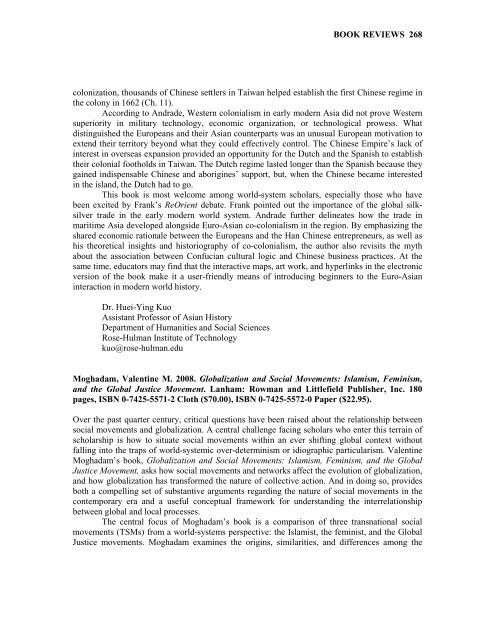Entire Volume 17 issue 1 - Journal of World-Systems Research ...
Entire Volume 17 issue 1 - Journal of World-Systems Research ...
Entire Volume 17 issue 1 - Journal of World-Systems Research ...
You also want an ePaper? Increase the reach of your titles
YUMPU automatically turns print PDFs into web optimized ePapers that Google loves.
BOOK REVIEWS 268<br />
colonization, thousands <strong>of</strong> Chinese settlers in Taiwan helped establish the first Chinese regime in<br />
the colony in 1662 (Ch. 11).<br />
According to Andrade, Western colonialism in early modern Asia did not prove Western<br />
superiority in military technology, economic organization, or technological prowess. What<br />
distinguished the Europeans and their Asian counterparts was an unusual European motivation to<br />
extend their territory beyond what they could effectively control. The Chinese Empire’s lack <strong>of</strong><br />
interest in overseas expansion provided an opportunity for the Dutch and the Spanish to establish<br />
their colonial footholds in Taiwan. The Dutch regime lasted longer than the Spanish because they<br />
gained indispensable Chinese and aborigines’ support, but, when the Chinese became interested<br />
in the island, the Dutch had to go.<br />
This book is most welcome among world-system scholars, especially those who have<br />
been excited by Frank’s ReOrient debate. Frank pointed out the importance <strong>of</strong> the global silksilver<br />
trade in the early modern world system. Andrade further delineates how the trade in<br />
maritime Asia developed alongside Euro-Asian co-colonialism in the region. By emphasizing the<br />
shared economic rationale between the Europeans and the Han Chinese entrepreneurs, as well as<br />
his theoretical insights and historiography <strong>of</strong> co-colonialism, the author also revisits the myth<br />
about the association between Confucian cultural logic and Chinese business practices. At the<br />
same time, educators may find that the interactive maps, art work, and hyperlinks in the electronic<br />
version <strong>of</strong> the book make it a user-friendly means <strong>of</strong> introducing beginners to the Euro-Asian<br />
interaction in modern world history.<br />
Dr. Huei-Ying Kuo<br />
Assistant Pr<strong>of</strong>essor <strong>of</strong> Asian History<br />
Department <strong>of</strong> Humanities and Social Sciences<br />
Rose-Hulman Institute <strong>of</strong> Technology<br />
kuo@rose-hulman.edu<br />
Moghadam, Valentine M. 2008. Globalization and Social Movements: Islamism, Feminism,<br />
and the Global Justice Movement. Lanham: Rowman and Littlefield Publisher, Inc. 180<br />
pages, ISBN 0-7425-5571-2 Cloth ($70.00), ISBN 0-7425-5572-0 Paper ($22.95).<br />
Over the past quarter century, critical questions have been raised about the relationship between<br />
social movements and globalization. A central challenge facing scholars who enter this terrain <strong>of</strong><br />
scholarship is how to situate social movements within an ever shifting global context without<br />
falling into the traps <strong>of</strong> world-systemic over-determinism or idiographic particularism. Valentine<br />
Moghadam’s book, Globalization and Social Movements: Islamism, Feminism, and the Global<br />
Justice Movement, asks how social movements and networks affect the evolution <strong>of</strong> globalization,<br />
and how globalization has transformed the nature <strong>of</strong> collective action. And in doing so, provides<br />
both a compelling set <strong>of</strong> substantive arguments regarding the nature <strong>of</strong> social movements in the<br />
contemporary era and a useful conceptual framework for understanding the interrelationship<br />
between global and local processes.<br />
The central focus <strong>of</strong> Moghadam’s book is a comparison <strong>of</strong> three transnational social<br />
movements (TSMs) from a world-systems perspective: the Islamist, the feminist, and the Global<br />
Justice movements. Moghadam examines the origins, similarities, and differences among the





